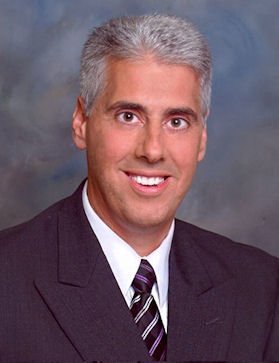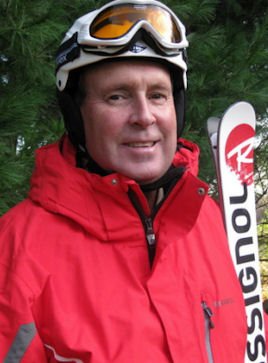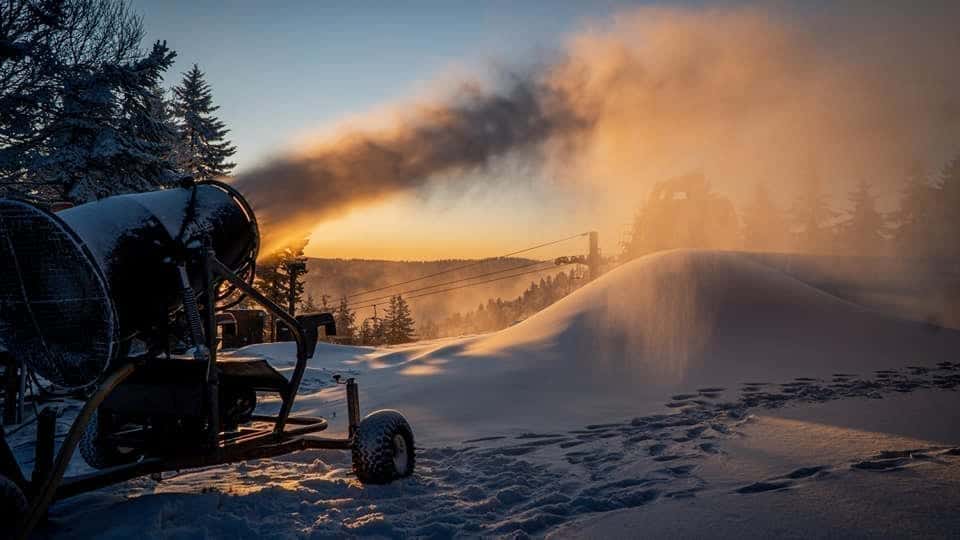WHAT THE EXPERTS THINK
Several Meteorologists Provide Their Ideas of What to Expect this Winter for the Southeastern and mid-Atlantic Ski Resorts
Story by Joe Stevens
Hello Everyone –
As I sit down to scribe this week’s Snow News Is Good News in Scott Depot, West Virginia the temperature outside our front door is 40-degrees, while the temperature at our farm located in the southern portion of Randolph County in West Virginia, about 13-miles from the top of Snowshoe Mountain is 32 degrees – while at the top at 4800 feet its 26 degrees with fresh natural snow and the guns are running and skiers and snowboarders are having lots of fun. My point is, while I’m in the flatlands, the weather is a lot different only three hours away in the mountains. Something to always consider when planning a trip to your favorite ski resort.
Before I get to this week’s main topic, (this season’s weather forecast), there were a couple of news items in the ski industry I wanted to mention, one very positive, one very sad.
 First the positive, on Wednesday it was announced that Perfect North Slopes had purchased out of bankruptcy, Timberline Ski Resort in West Virginia. Most of you know, I am the Executive Director of the West Virginia Ski Areas Association. Not to dwell on the entire story, which Mike Doble had as a lead story on this site, when the news broke it sent very positive shock waves throughout the state’s ski industry as Perfect’s reputation as a resort area operator is awesome and when the resort opens back up next season, that will be great for skiers and snowboarders in the region.
First the positive, on Wednesday it was announced that Perfect North Slopes had purchased out of bankruptcy, Timberline Ski Resort in West Virginia. Most of you know, I am the Executive Director of the West Virginia Ski Areas Association. Not to dwell on the entire story, which Mike Doble had as a lead story on this site, when the news broke it sent very positive shock waves throughout the state’s ski industry as Perfect’s reputation as a resort area operator is awesome and when the resort opens back up next season, that will be great for skiers and snowboarders in the region.

Now for the sad, late last week it was announced the passing of snowboard pioneer Jake Burton Carpenter. Jake put snowboarding on the map and because of him, snowboarding is part of how millions enjoy playing on the snow. He always thought ahead of the curve and frankly didn’t care what the experts said, he was always looking out, how to make the sport more fun for those who used only one plank to go downhill. RIP, Jake, my first turns on my Burton Custom will be for you this season.
Like I have done since starting this column 15 years ago (Mike we are getting gray), I again checked out what some of my friendly and well dialed in weather experts thought was going to take place this season for skiers and snowboarders in the Southeast and mid-Atlantic regions. Here are their forecasts:
 From long time weather forecasting friend Sean Sublette, who is a staff meteorologist at Climate Matters in New Jersey. Here is what Sean is forecasting for this year:
From long time weather forecasting friend Sean Sublette, who is a staff meteorologist at Climate Matters in New Jersey. Here is what Sean is forecasting for this year:
Seasonal forecasting is always tricky, but there is probably just enough of an environmental signal to skew the ski season toward a favorable one in the Middle Atlantic and the Southeast.
First off is the ENSO… short for the El Niño – Southern Oscillation. The positive phase indicates warmer than normal water in the eastern Pacific near the equator, and the negative phase (often called La Niña) indicates colder than normal water in the eastern Pacific near the equator. These have a large impact on the amount of precipitation in the Southeast and sometimes the Middle Atlantic. But right now, that phase is close to the middle… so probably not a lot of influence there.
But there are few other things that snow lovers have going for them as we get closer to the start of meteorological winter on December 1. First, there is very warm water in the northeastern Pacific Ocean, about 4-5°F above normal. That lends itself to dry and warm conditions for the winter ahead in the western part of the country, leaving the eastern half colder and wetter.
The country is also in the midst of its wettest calendar year on record, with the focus of the 2019 rain, and thus greatest soil moisture, in the Mississippi Valley watershed areas. Those areas create an upside-down triangle: from Montana to western New York State and then southward to the Gulf Of Mexico. This high level of soil moisture also tends to correlate with a cool and damp winter ahead in the eastern half of the country.
Finally, the 11-year sunspot cycle is nearing its minimum. A less active sun often translates to a colder than normal winter in the eastern U.S.
These all suggest the opportunity for a colder than normal winter with above normal precipitation in the resorts of the Middle Atlantic and the Southeast, which we could read as a better than average snow year. Having said that, we do need to remember than the overall background climate has been warming relative to about 50 years ago, so even with the shorter-term colder signals in place, a whopper of a snow year is not expected. We will also have a couple of warm spells which could take a big bite out of the snow bases in January or February.
My best guess is for snow totals to be about 100-130% of normal. So a good year, but not a record breaking year.
 Again, this year, I reached out to a weatherman, who is also a ski instructor, Joe Murgo, Chief Meteorologist at WTAJ-TV in Altoona, PA. Here are his thoughts:
Again, this year, I reached out to a weatherman, who is also a ski instructor, Joe Murgo, Chief Meteorologist at WTAJ-TV in Altoona, PA. Here are his thoughts:
This year there is neither an El Nino nor La Nina as temperatures across the tropical Pacific are close to average, a neutral condition sometimes called La Nada. This leaves us open to the other influences including what happens in other ocean locations and comparing them to similar setups from the past. The similar, analog years that I found this year include 1982, 2004, 2007, 2013, 2014 and last year.
Once again, we have a blob of warm water lying off of the Gulf of Alaska, but it is centered farther to the west than last year. The warmth in this position sends the jet stream into Alaska and opens up a pipeline of arctic air into the western and mid-section of the nation. While most of this cold will be aimed to our west, during the height of the winter season, this cold air will spill into the Mid-Atlantic and Southeast. This on top of fast snow growth in Canada (which helped the November cold) will help us to get some arctic blasts. Therefore, I believe we will have near to above average temperatures for later November through December, but the core of the cold will be around from mid-January through mid-February. This will put us in good position for snowmaking in the heart of the season.
So, what about the snow that comes from Mother Nature. I think the East Coast storm track will not be favorable for many big dumps of snow with most of our snow coming with clipper systems and arctic fronts. This really does favor some of the resorts in Maryland and West Virginia and there will be some spillover northwestern flow snows down to the Carolinas.
Now let’s see what Brad Panovich, Meteorologist, WCNC-TV, Charlotte, NC and Skisoutheast.com’s Chief Weather forecaster thinks:

I think finally after several years of warm and low snow totals there a real chance we could see a decent year in the Southeast.
The combination of a weak El Nino which gives us a favorable storm track and even near average temperatures would be an improvement over the past 3 seasons for sure. While there aren’t many strong signals for a really cold winter. The signals are strong for a wet winter. Which means our chances of numerous winter storms is higher than in the dry seasons the past 3 years.
So, my forecast is for a wet winter with near average to even slightly below average temperatures. Keep thinking snow!!!
Let’s hear from another, West Virginia mountain forecaster, Doug Harlow, Chief Meteorologist of WCHS-TV in Charleston, West Virginia:
 Long-range Winter forecasting is always difficult, and this year appears even more so given the lack of strong signals. Usually we look to see whether El Nino (warmer Central/East-Central Pacific waters) or La Nina (colder Central/East-Central Pacific waters) are established. This year neither is…it’s what we call an ENSO (El Nino Southern Oscillation) neutral pattern. What do those typically produce in our region? No real trend is apparent, with neutral patterns since 1980 producing about the same number of colder Winters as warmer ones.
Long-range Winter forecasting is always difficult, and this year appears even more so given the lack of strong signals. Usually we look to see whether El Nino (warmer Central/East-Central Pacific waters) or La Nina (colder Central/East-Central Pacific waters) are established. This year neither is…it’s what we call an ENSO (El Nino Southern Oscillation) neutral pattern. What do those typically produce in our region? No real trend is apparent, with neutral patterns since 1980 producing about the same number of colder Winters as warmer ones.
November 2019 will go down as one of the coldest on record, but history shows that a colder November doesn’t always signify a subsequently cold Winter. Of the top 10 coldest Novembers in our area, half were followed by colder than normal Winters (including the brutal 1976-77 Winter) while half were warmer than average. In fact, November 2018 was colder than usual, but the Winter was warmer than normal.
We’ll likely be relying on the Arctic Oscillation (AO), which can go positive or negative depending on whether high pressure or low pressure is present over the Arctic. Negative AO from high pressure over the arctic signifies colder than normal weather in the East and vice versa. Unfortunately, the AO can swing wildly over the season and is very difficult to predict with any accuracy. Hence in mid-October the signals pointed to a warm upcoming November, but by the end of October a negative AO took hold and resulted in a very cold month. I suspect we’ll see these kinds of swings this season. December appears to start off near or slightly below normal, but the second half of the month may trend warm as a positive AO takes shape. After that I would expect more temperature swings through January and February, but with more snow on the ground over Siberia than usual I suspect more frequent periods of negative AO and hence colder weather.
Overall, I expect near-normal temperatures and snowfall this winter but given that it’s been five years since we’ve had a near-normal or colder than normal Winter this one may seem harsher. Of course, that’s great news for skiers!
 Let’s hear from another West Virginia mountain forecaster, Brandon Butcher, Morning Meteorologist for WSAZ-TV in Huntington, West Virginia:
Let’s hear from another West Virginia mountain forecaster, Brandon Butcher, Morning Meteorologist for WSAZ-TV in Huntington, West Virginia:
So recent years’ natural snow has been a little down as of late. Just the law of averages would dictate that we’re due for a year that would revert us closer to an average year (or even put us over for a change), but alas that’s not all the information we have for a seasonal snowfall forecast. Even though the basic skill indicator for a seasonal snow forecast is to correctly assess what side of ‘average’ an area will land, there is a lot that can actually go into that brew.
Currently, prevailing Pacific Ocean signals (largest Ocean in the world, often a big driver of global weather patterns) are aiming for a “Neutral” year in terms of the famous “El Nino / La Nina” scenario; if anything, just a touch toward El Nino. The typical weather pattern in this steering current has already been witnessed by the above-average snowfall for the Northern US Plains and Canada so far — a digging jet stream that funnels cold air out of Canada then looks to eventually curve back northward. In Neutral years, the common idea is that a ‘subtropical’ jet meets up with this digging area of cold air, materializing into some decent systems, but does so too far to the north to take advantage — meaning we get that “under-developed” precipitation. The prevailing estimation is that this winter will be a touch warmer and wetter than average — but even that is not the end of the story!
Most ski resorts in the southeast are unusually high spots that actually spend most of their deep winter months fending off frights of sub-zero wind chills and rumors of treacherous roads. Cutting a couple degrees off that isn’t all bad, as it still can keep you in the snow category (especially for making snow) as well as encourage more folks to venture out when the snows do end up coming. In addition, given a ‘wetter’ year, there’s always a decent shot at getting a nicely-timed wallop that leaves you with oodles of fresh powder while the lowlands get just enough to remind them of skiing without the worry of navigating the roads to the resort. In the end, it is a forecast that calls for another below-average year for ‘natural’ snow, but one that will be better than last year– and one that can still lend itself to decent snow-making conditions as well as a shot at that big snow event that can keep the powder going for many days!
Let’s hear from a down south meteorologist, Dave Osterberg, Morning Meteorologist for FOX13, WTVT-TV in Tampa, Florida:
 As the ski season rapidly approaches, it’s time again to look into the long-term forecast for the southeast U.S. First thing to note is that the El Niño from last winter is long gone, and the extended forecasts call for neutral conditions. In fact, there is over a 50% chance of neutral conditions through early 2020. That will likely mean that winter conditions will be driven by smaller circulations like the Arctic Oscillation. This will likely result in large swings in temperatures, unlike last year where is was noticeably above normal through the season.
As the ski season rapidly approaches, it’s time again to look into the long-term forecast for the southeast U.S. First thing to note is that the El Niño from last winter is long gone, and the extended forecasts call for neutral conditions. In fact, there is over a 50% chance of neutral conditions through early 2020. That will likely mean that winter conditions will be driven by smaller circulations like the Arctic Oscillation. This will likely result in large swings in temperatures, unlike last year where is was noticeably above normal through the season.
The problem with these Arctic Oscillations they are very hard to predict more than two weeks out. The winter temps for the Southeast are expected to be slightly above normal, with near normal precipitation.
So, cross your fingers that will mean at least near normal snowfall. Happy Skiing!!!!!!!
Finally, we turn to Herb Stevens, a long-time meteorologist and recognized for over 25 years along the east coast as The Skiing Weatherman; his thoughts on this season’s weather is as follows:
 Looking ahead to the winter…one that has gotten off to a fast start…I always look at what is going on in the Pacific Ocean first. Is there an El Nino in progress? A La Nina? Neither? Where are the warm and cool pools located and how big are they? Given that the oceans of this planet contain 1,000 TIMES the energy of the atmosphere, a forecaster ignores these questions at their peril, in my opinion. There are well researched and documented correlations between the state of affairs upstream in the Pacific and the weather that results in the winter downstream over the United States and adjacent Canada.
Looking ahead to the winter…one that has gotten off to a fast start…I always look at what is going on in the Pacific Ocean first. Is there an El Nino in progress? A La Nina? Neither? Where are the warm and cool pools located and how big are they? Given that the oceans of this planet contain 1,000 TIMES the energy of the atmosphere, a forecaster ignores these questions at their peril, in my opinion. There are well researched and documented correlations between the state of affairs upstream in the Pacific and the weather that results in the winter downstream over the United States and adjacent Canada.
So, what is going on in the Pacific? Well, the weak El Nino of last winter has pretty much disappeared. Neutral conditions are now dominant in the tropical waters where warm (El Nino) and cold (La Nina) pools can be found, and overall, a neutral signal is now in place…a friend of mine coined the term “La Nada” for such a signal. Although there is not a strong indication coming from those waters, it is worth noting that the waters of the central tropical Pacific are warmer than the water at the same latitude further east, closer to the shores of South America. That relationship generally correlates with favorable winters in the central and southern Appalachians. When the low latitude eastern Pacific waters are warmer than the central region, mild winters usually are favored.
The other feature present in the Pacific is a large pool of warmer than normal water covering the waters of the Gulf of Alaska southeastward along the British Columbia coast. That pool is similar in size and location to recent winters of 2013-14 and 2014-15, both of which were good for skiers and snowboarders in the mountains of the Mid-Atlantic. Many other winters, stretching all the way back to 1917-18, ended up cold and snowy over the eastern U.S. with a warm pool in the same location. How does it work? Well, the warm pool helps support a ridge at the jet stream level sitting overhead. The jet stream is a river of air that has peaks and valleys (ridges and troughs) strung out across the entire hemisphere. Generally speaking, when a ridge builds in one place, a trough forms downstream of that ridge. In this case, the western trough will work in concert with an eastern trough and the circulation around the two features (clockwise ridge/counterclockwise trough) will tap into cold air from the high latitudes on a consistent basis, enough to bring Southeastern resorts a colder and snowier than normal winter of 2019-20.
Well there you have it, sounds like a promising season on the horizon, weather-wise for everyone wanting to play at their favorite resort in the southeast.
That’s it for this week, more to come as the season continues. Just remember whether it be cold or whether it be hot, we’ll weather the weather, whatever the weather will be. Think about it! See you on the slopes.

